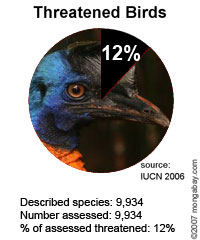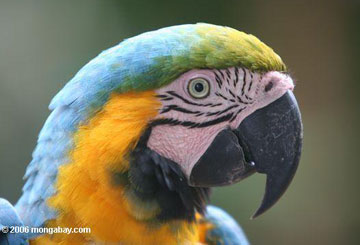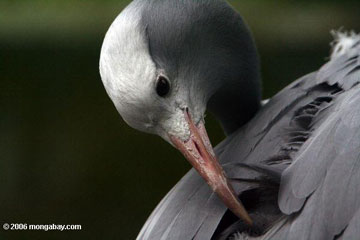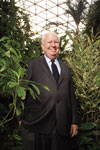10-20% of birds extinct by 2100 due to global warming, deforestation
10-20% of birds extinct by 2100 due to global warming, deforestation
mongabay.com
June 4, 2007
Ten to twenty percent of the world’s terrestrial bird species could be threatened with extinction by 2100 due to climate change and habitat destruction reports a study published in the June 5 issue of the journal PLoS Biology. The numbers are in line with estimates published last year in The Proceedings of the National Academy of Sciences.
Combining future projections on global warming, agricultural expansion and human population growth from the global Millennium Ecosystem Assessment with current geographic ranges of the world’s 8,750 species of terrestrial birds, researchers Walter Jetz, David Wilcove, and Andrew Dobson estimate that 950 to 1800 species may be condemned to extinction by 2100.
“We found in our study that under certain assumptions by the year 2100, 950 to 1,800 bird species may be imperiled or even driven to extinction by climate change and habitat destruction,” says Walter Jetz, an assistant professor of biological sciences at the University of California at San Diego (UCSD) and the lead author of the study. “Most of these species are currently not recognized as imperiled.”

|
The authors say that in the near term, deforestation and habitat conversion are a larger threat to terrestrial bird species than climate change, but that after 2050 climate will have an increasingly important impact of the survival of terrestrial birds.
“It’s clear that both climate change and habitat destruction pose grave threats to many of the world’s birds and, by analogy, to other species as well,” says David Wilcove, a professor of ecology, evolutionary biology and public affairs at Princeton University and a co-author of the study. “Neither problem can be addressed in a vacuum.”
“The most intense climate change is expected at higher latitudes, where birds are relatively species-poor and have large ranges,” added Jetz. “Dramatic levels of deforestation and other forms of land conversion are projected to continue or even increase in much of the tropics. There birds and most other taxonomic groups are especially diverse and tend to have small ranges, making them particularly vulnerable to extinction.”

Blue and yellow macaw in Colombia. Photo by Rhett A. Butler |
“This is akin to killing two birds with one stone,” explained Wilcove. “Deforestation drives tropical species to extinction and also contributes to global climate change. Climate change, in turn, drives temperate species to extinction. The good news is that by halting deforestation we can protect both tropical and temperate birds.”
Humans have already caused the extinction of around 1,000 bird species over the past millennium, especially in the South Pacific. Places like Hawaii and modern-day French Polynesia lost more than 80 percent of their endemic species.
The scientists warn that even under the most optimistic scenarios of slowing climate change and protecting critical habitats, at least 400 bird species are likely to become imperiled by the year 2050 due to reductions in their geographic ranges of greater than 50 percent, assuming that birds will not dramatically shift their geographic ranges in response to a changing climate.
The researchers say the best to minimize extinctions is to significantly expand protected areas while aggressively cutting greenhouse gas emissions and reducing deforestation.

Photo by Rhett A. Butler |
“The tragic irony here is that the protection of tropical forests is also one of the strongest buffers against future climate change,” said Andrew Dobson, the third author of the paper and a professor of ecology and evolutionary biology at Princeton. “It is crucial that international environmental policy be swiftly developed to focus both on climate change and on habitat loss; the two are not only intimately related, but are arguably the greatest threats not only to birds, but also to human welfare and economic well-being.”
“These hundreds of bird species headed toward extinction are like thousands of dying canaries in coal mines,” Dobson adds. “It’s time we paid attention to them.”
Related articles

|
Peter Raven, director of the Missouri Botanical Garden Biodiversity extinction crisis looms says renowned biologist — 03/12/2007 While there is considerable debate over the scale at which biodiversity extinction is occurring, there is little doubt we are presently in an age where species loss is well above the established biological norm. Extinction has certainly occurred in the past, and in fact, it is the fate of all species, but today the rate appears to be at least 100 times the background rate of one species per million per year and may be headed towards a magnitude thousands of times greater. Few people know more about extinction than Dr. Peter Raven, director of the Missouri Botanical Garden. He is the author of hundreds of scientific papers and books, and has an encyclopedic list of achievements and accolades from a lifetime of biological research. These make him one of the world’s preeminent biodiversity experts. He is also extremely worried about the present biodiversity crisis, one that has been termed the sixth great extinction. |
1250 bird species may be extinct by 2100
Two new studies paint a mixed future for the world’s bird populations, one suggesting that 12 percent of existing species could be extinct by 2100 and the other finding shifts in migration patterns among birds that migrate long distances. Researchers at Stanford University, Duke University and the Missouri Botanical Garden in St. Louis examined the extinction record for birds and found that scientists have likely underestimated the number of extinctions. Until now, scientists has documented the extinction of about 130 bird species since 1500 but the new research, published in Proceedings of the National Academy of Sciences, argues that the actual number is closer to 500, indicating an extinction rate of about a bird species per year. The scientists warn that this rate could climb to five species per year before the century ends, impoverishing earth of some 1250 species of birds.
Global warming could doom many bird species
Up to 72 percent of bird species in northeastern Australia and more than a third in Europe could go extinct unless action is taken to address global warming said a report from environmental group WWF. The report, “Bird Species and Climate Change: The Global Status Report”, reviews more than 200 scientific articles on birds and identifies groups of birds at high risk from climate change: migratory, mountain, island, wetland, Arctic, Antarctic and seabirds. It says that species that can easily migrate to new habitats will likely thrive, while birds that live in niche environments may decline.
Birds Face Extinction Risk Due To Human Activities
Human activities have caused some 500 bird species worldwide to go extinct over the past five millennia, and 21st-century extinction rates likely will accelerate to approximately 10 additional species per year unless societies take action to reverse the trend, according to a new report.